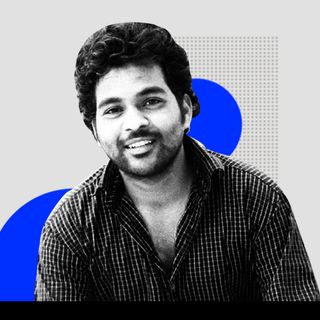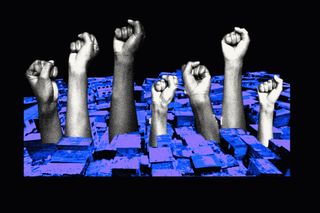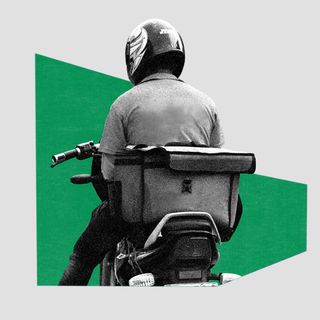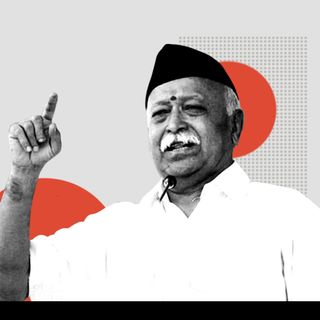
Why Are Dharavi’s Residents Protesting Adani’s Redevelopment Plan?
At the heart of the protests is the assertion that it should be the residents of Dharavi who decide what redevelopment means to them.

The residents of Dharavi are protesting against the proposed redevelopment of the area by one of India’s largest business conglomerates, the Adani Group. Towards the end of 2022, the Adani Group won a bid to redevelop Dharavi, a colossal slum cluster situated on prime commercial land in Mumbai, close to the business district of BKC. Touted as the “world’s largest urban renewal project,” the makeover of 260 hectares of the settlement potentially entails the displacement of around 65,000 families.
According to V.R. Srinivas, CEO of the Dharavi Redevelopment Project, the goal of the redevelopment by Adani Group is the “formalization of the unorganized economy” and “the first step towards making Mumbai slum-free [which] will change the face of the city.” As for the rehabilitation of the residents, the goal is to “build free houses with services like water and power supply, sewage disposal, piped gas… for qualified slum-dwellers.”
However, residents and activists are worried. More so, since this isn’t the first time that the goal to monetize Dharavi has been presented under the garb of an “improvement scheme,” as Hussain Indorewala, who teaches at the Kamla Raheja Vidyanidhi Institute of Architecture and Environmental Studies in Mumbai, noted.
At the core of the issue in the protests is that the decision to improve the lives of Dharavi’s million-strong residents doesn’t take their agency into account. “People like me have nurtured Dharavi for decades. Now suddenly we’re being told that we’ll be shifted to a ‘better home’. But has anybody even bothered to ask us if we really want to do that? We’re happy here only,” Kanta Bai, 70, who has been selling vegetables in the area for over three decades, told Nikkei Asia. Dharavi’s proposed redevelopment, then, is a conjugation of two elements: first, the exploitation of the economically underprivileged; second, a top-down definition of development that imposes life-altering changes on marginalized citizens.
Related on The Swaddle:
Travel Companies Offering ‘Slum Tours’ Raises Ethical Concerns About Making Poverty an ‘Aesthetic’
How Dharavi is constructed in the public’s imagination is key to the perception that it needs redevelopment. “Dharavi is maligned as a dirty slum, but I noticed there are large areas, which are perfectly in good shape,” wrote Vidyadhar Date, a journalist, citing examples of a clean, vibrant garden with a gazebo and wooden benches, and a bustling fresh vegetable market, whose “vibrancy would be the envy of Westerners.” According to Date, indeed, “there are large pockets of insanitation… due to civic neglect,” but instead of placing the blame where it’s due, “Dharavi has been deliberately… given a bad name as a dirty area, so that it can be redeveloped for profits for some.”
The media, too, has been complicit in shaping the public perception of Dharavi as a filthy locale in need of redevelopment — often in a bid to create poverty and inspiration porn. This fuels voyeurism into the lives of its residents: Dharavi beat even the Taj Mahal — a literal “wonder of the world” — as a more popular tourist destination when travel companies began promoting “slum tourism” in the area. All this has ultimately led to the present predicament of the residents, who may soon lose their open spaces, and be “confined to high-rise buildings with little public space because most of the space will be used for luxury housing for the wealthy,” as Indorewala noted.
Worse still, it may adversely impact the livelihoods of residents too, making their economic conditions worse. “My work requires me to have unhindered access to open space. Dharavi, where I’ve been living for 25 years, allows me that. My business will be finished if I’m perched on the 10th floor. My wares are very fragile and climbing up and down a building with them will result in a lot of breakage[s]. I can ill-afford this as my business is still recovering post-Covid. Plus, I need a big kiln to bake my clay products, and I doubt if a tiny flat will allow that,” says Lakshmikant Patil, a 56-year-old potter from Dharavi. “Nobody even asked us whether we wanted to leave the slum or not. Nor have we been told where we’ll be shifted. My family’s future is looking very uncertain.”
Experts, too, have expressed similar concerns. “The primary concern is rehabilitating such a huge number of people with disparate needs. Slum dwellers do not adapt well to high rises because their living and working requires them to be close to the ground. Global studies have proven how the urban poor put in high rises not only leads to a surge in crime, but also a breakdown of social ties among them as well as deterioration of the building itself,” notes Prem Chandavarkar, an architect from Bengaluru.
Related on The Swaddle:
How the Design of Our Cities Reflects Caste, Class Anxieties
It is pertinent to note that, in theory, redevelopment that ensures clean running water, basic sanitation facilities, and better housing, can be a good thing. However, it is the manner of implementation of the plans that has the residents worried — especially so, since the conglomerate in charge of the redevelopment has been “accused of causing development-induced displacement,” in the past.
To a large extent, then, the residents of Dharavi protesting redevelopment point to an assertion of their needs as they have defined them. Speaking to Hindustan Times, Gautam Chatterjee, former state housing department secretary who was in charge of the redevelopment project earlier, said, “Dharavi is an informal industrial township, and a regular slum redevelopment plan cannot work here. We need to think [of] out-of-the-box solutions to ensure that people’s livelihoods are protected in this revamp apart from giving them new houses. The workers working in small-scale units, too, need to be taken into consideration which is not the case at present. There is bound to be resistance among residents as they perceive this project as more of a displacement rather than rehabilitation.”
Last year, too, the residents had intensified their agitation when the government began seeking fresh bids for the redevelopment of the area, but to no avail.
The economic value of Dharavi, moreover, is not despite its residents and landscape — arguably, it’s because of it. “Almost everything admirable about Dharavi is made by its numerous communities, and almost everything that is disagreeable is the result of municipal neglect. Dharavi’s staggering land value has been collectively produced over the decades, much of it by the labor of residents themselves,” Indorewala wrote. “They transformed a swamp on the periphery of the city into habitable land, and produced an industrial and residential economy that provides homes and jobs to millions. Why should this be siphoned away by a company that has done absolutely nothing to make it what it is worth?”
Devrupa Rakshit is an Associate Editor at The Swaddle. She is a lawyer by education, a poet by accident, a painter by shaukh, and autistic by birth. You can find her on Instagram @devruparakshit.
Related


Swiggy Delivery Worker’s Death Prompts Action Against Pet Owners – But Lack of Labor Protections Remains Unaddressed
